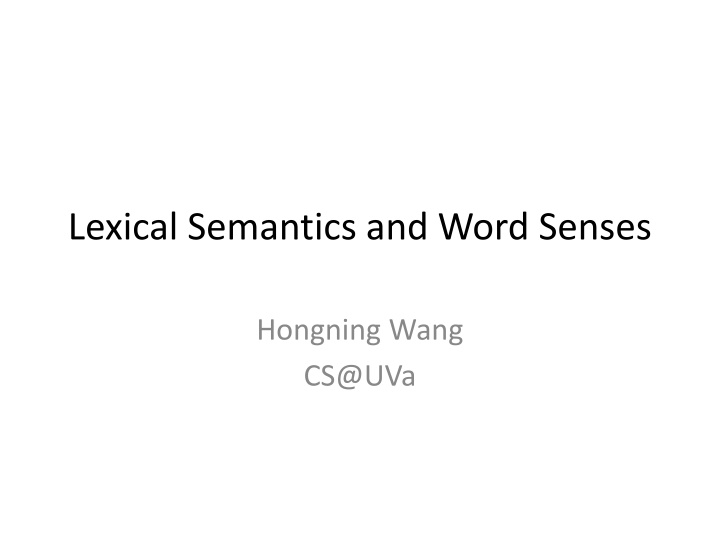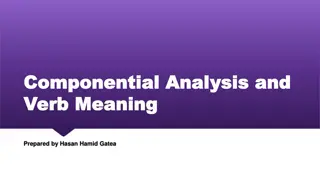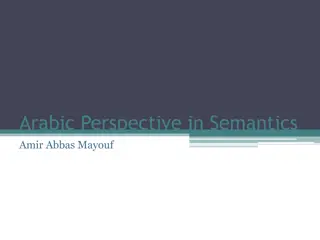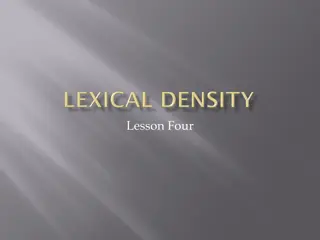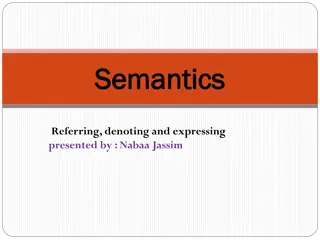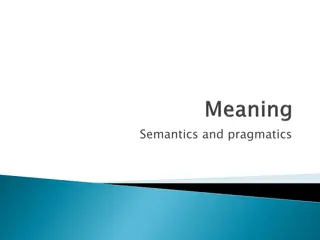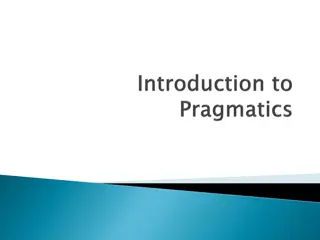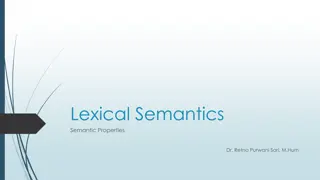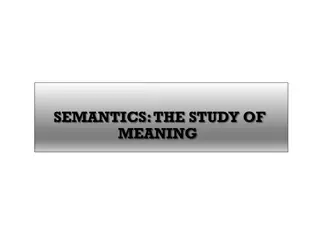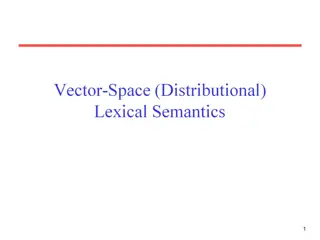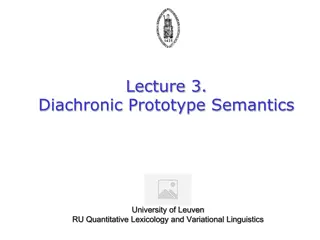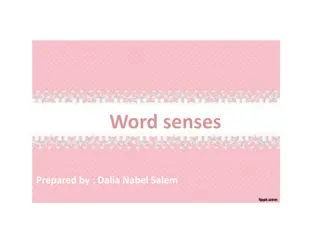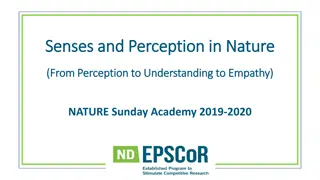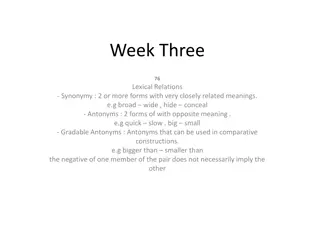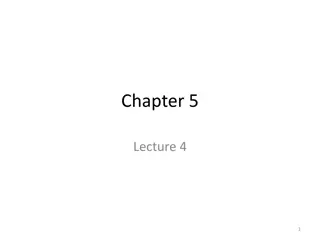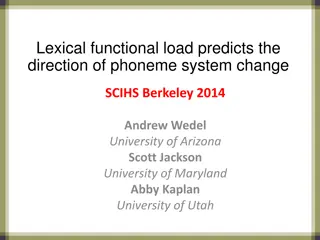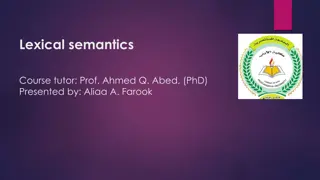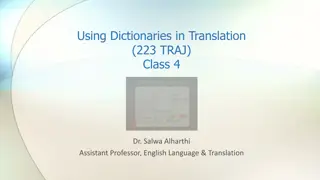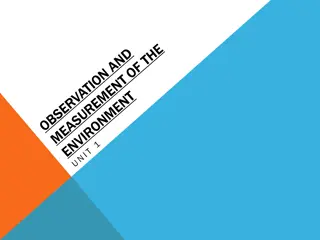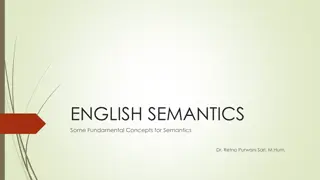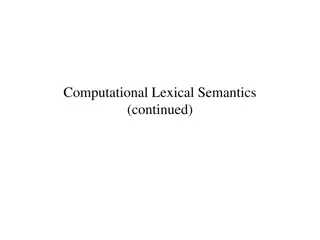Lexical Semantics and Word Senses
Delve into the intricate world of lexical semantics, word senses, and word meanings. Understand the relations between different meanings, explore concepts like polysemy and homonyms, and grasp the nuances of lexical entries and terminologies. Discover how words can have multiple senses and how these senses are interconnected in the vast landscape of language.
Download Presentation

Please find below an Image/Link to download the presentation.
The content on the website is provided AS IS for your information and personal use only. It may not be sold, licensed, or shared on other websites without obtaining consent from the author.If you encounter any issues during the download, it is possible that the publisher has removed the file from their server.
You are allowed to download the files provided on this website for personal or commercial use, subject to the condition that they are used lawfully. All files are the property of their respective owners.
The content on the website is provided AS IS for your information and personal use only. It may not be sold, licensed, or shared on other websites without obtaining consent from the author.
E N D
Presentation Transcript
Lexical Semantics and Word Senses Hongning Wang CS@UVa
Todays lecture 1. Lexical semantics Meaning of words Relation between different meanings 2. WordNet An ontology structure of word senses Similarity between words 3. Distributional semantics Similarity between words Word sense disambiguation CS@UVa CS 6501: Text Mining 2
What is the meaning of a word? Most words have many different senses dog = animal or sausage? lie = to be in a horizontal position or a false statement made with deliberate intent What are the relations of different words in terms of meaning? Specific relations between senses Animal is more general than dog Semantic fields Money is related to bank a set of words grouped, referring to a specific subject not necessarily synonymous, but are all used to talk about the same general phenomenon - wiki CS@UVa CS 6501: Text Mining 3
Word senses What does bank mean? A financial institution E.g., US bank has raised interest rates. A particular branch of a financial institution E.g., The bank on Main Street closes at 5pm. The sloping side of any hollow in the ground, espe cially when bordering a river E.g., In 1927, the bank of the Mississippi flooded. A repository E.g., I donate blood to a blood bank. CS@UVa CS 6501: Text Mining 4
Lexicon entries lemma senses CS@UVa CS 6501: Text Mining 5
Some terminologies Word forms: runs, ran, running; good, better, best Any, possibly inflected, form of a word Lemma (citation/dictionary form): run; good A basic word form (e.g. infinitive or singular nominative noun) that is used to represent all forms of the same word Lexeme: RUN(V), GOOD(A), BANK1(N), BANK2(N) An abstract representation of a word (and all its forms), with a part-of-speech and a set of related word senses Often just written (or referred to) as the lemma, perhaps in a different FONT Lexicon A (finite) list of lexemes CS@UVa CS 6501: Text Mining 6
Make sense of word senses Polysemy A lexeme is polysemous if it has different related senses bank = financial institution or a building CS@UVa CS 6501: Text Mining 7
Make sense of word senses Homonyms Two lexemes are homonyms if their senses are unrelated, but they happen to have the same spelling and pronunciation bank = financial institution or river bank CS@UVa CS 6501: Text Mining 8
Relations between senses Symmetric relations Synonyms: couch/sofa Two lemmas with the same sense Antonyms: cold/hot, rise/fall, in/out Two lemmas with the opposite sense Hierarchical relations: Hypernyms and hyponyms: pet/dog The hyponym (dog) is more specific than the hypernym (pet) Holonyms and meronyms: car/wheel The meronym (wheel) is a part of the holonym (car) CS@UVa CS 6501: Text Mining 9
WordNet George Miller, Cognitive Science Laboratory of Princeton University, 1985 A very large lexical database of English: 117K nouns, 11K verbs, 22K adjectives, 4.5K adverbs Word senses grouped into synonym sets ( synsets ) linked into a conceptual-semantic hierarchy 82K noun synsets, 13K verb synsets, 18K adjectives synsets, 3.6K adverb synsets Avg. # of senses: 1.23/noun, 2.16/verb, 1.41/adj, 1.24/adverb Conceptual-semantic relations hypernym/hyponym CS@UVa CS 6501: Text Mining 10
A WordNet example http://wordnet.princeton.edu/ CS@UVa CS 6501: Text Mining 11
Hierarchical synset relations: nouns Hypernym/hyponym (between concepts) The more general meal is a hypernym of the more specific breakfast Instance hypernym/hyponym (between concepts and instances) Austen is an instance hyponym of author Member holonym/meronym (groups and members) professor is a member meronym of (a university s) faculty Part holonym/meronym (wholes and parts) wheel is a part meronym of (is a part of) car. Substance meronym/holonym (substances and components) flour is a substance meronym of (is made of) bread Jane Austen, 1775 1817, English novelist CS@UVa CS 6501: Text Mining 12
WordNet hypernyms & hyponyms CS@UVa CS 6501: Text Mining 13
Hierarchical synset relations: verbs the presence of a manner relation between two lexemes Hypernym/troponym (between events) travel/fly, walk/stroll Flying is a troponym of traveling: it denotes a specific manner of traveling Entailment (between events): snore/sleep Snoring entails (presupposes) sleeping CS@UVa CS 6501: Text Mining 14
Recap: what is the meaning of a word? Most words have many different senses dog = animal or sausage? lie = to be in a horizontal position or a false statement made with deliberate intent What are the relations of different words in terms of meaning? Specific relations between senses Animal is more general than dog Semantic fields Money is related to bank a set of words grouped, referring to a specific subject not necessarily synonymous, but are all used to talk about the same general phenomenon - wiki CS@UVa CS 6501: Text Mining 15
Recap: WordNet A very large lexical database of English: 117K nouns, 11K verbs, 22K adjectives, 4.5K adverbs Word senses grouped into synonym sets ( synsets ) linked into a conceptual-semantic hierarchy 82K noun synsets, 13K verb synsets, 18K adjectives synsets, 3.6K adverb synsets Avg. # of senses: 1.23/noun, 2.16/verb, 1.41/adj, 1.24/adverb Conceptual-semantic relations hypernym/hyponym CS@UVa CS 6501: Text Mining 16
WordNet similarity Path based similarity measure between words Shortest path between two concepts (Leacock & Chodorow 1998) sim = 1/|shortest path| Path length to the root node from the least common subsumer (LCS) of the two concepts (Wu & Palmer 1994) sim = 2*depth(LCS)/(depth(w1)+depth(w2)) http://wn-similarity.sourceforge.net/ the most specific concept which is an ancestor of both A and B. CS@UVa CS 6501: Text Mining 17
WordNet::Similarity CS@UVa CS 6501: Text Mining 18
WordNet::Similarity CS@UVa CS 6501: Text Mining 19
Distributional hypothesis What is tezg ino? A bottle of tezg ino is on the table. Everybody likes tezg ino. Tezg ino makes you drunk. We make tezg ino out of corn. The contexts in which a word appears tell us a lot about what it means CS@UVa CS 6501: Text Mining 20
Distributional semantics Use the contexts in which words appear to measure their similarity Assumption: similar contexts => similar meanings Approach: represent each word ? as a vector of its contexts ? Vector space representation Each dimension corresponds to a particular context ?? Each element in the vector of ? captures the degree to which the word ? is associated with the context ?? Similarity metric Cosine similarity CS@UVa CS 6501: Text Mining 21
How to define the contexts within a sentence Nearby words ? appears near ? if ? occurs within ? words of ? It yields fairly broad thematic relations Decide on a fixed vocabulary of ? context words ?1..?? Prefer words occur frequently enough in the corpus but not too frequent (i.e., avoid stopwords) Co-occurrence count of word ? and context ? as the corresponding element in the vector Pointwise Mutual Information (PMI) Grammatical relations How often is ? used as the subject of the verb ?? Fine-grained thematic relations CS@UVa CS 6501: Text Mining 22
Mutual information Relatedness between two random variables ?(?,?) ? ? ?(?)) ? ?;? = ? ? ? ??(?,?)log( CS@UVa CS 6501: Text Mining 23
Pointwise mutual information within a sentence PMI between w and c using a fixed window of ? words ?(?,?) ? ? ?(?)) ??? ?;? = ?(?,?)log( How often ? and ? co- occur inside a window How often ? occurs How often ? occurs CS@UVa CS 6501: Text Mining 24
Word sense disambiguation What does this word mean? This plant needs to be watered each day. living plant This plant manufactures 1000 widgets each day. factory Word sense disambiguation (WSD) Identify the sense of content words (noun, verb, adjective) in context (assuming a fixed inventory of word senses) watered manufactures CS@UVa CS 6501: Text Mining 25
Dictionary-based methods A dictionary/thesaurus contains glosses and examples of a word bank1 Gloss: a financial institution that accepts deposits and channels the money into lending activities Examples: he cashed the check at the bank , that bank holds the mortgage on my home bank2 Gloss: sloping land (especially the slope beside a body of water) Examples: they pulled the canoe up on the bank , he sat on the bank of the river and watched the current CS@UVa CS 6501: Text Mining 26
Lesk algorithm Compare the context with the dictionary definition of the sense Construct the signature of a word in context by the signatures of its senses in the dictionary Signature = set of context words (in examples/gloss or in context) Assign the dictionary sense whose gloss and examples are the most similar to the context in which the word occurs Similarity = size of intersection of context signature and sense signature context words CS@UVa CS 6501: Text Mining 27
Sense signatures bank1 Gloss: a financial institution that accepts deposits and channels the money into lending activities Examples: he cashed the check at the bank , that bank holds the mortgage on my home Signature(bank1) = {financial, institution, accept, deposit, channel, money, lend, activity, cash, check, hold, mortgage, home} bank2 Gloss: sloping land (especially the slope beside a body of water) Examples: they pulled the canoe up on the bank , he sat on the bank of the river and watched the current Signature(bank1) = {slope, land, body, water, pull, canoe, sit, river, watch, current} CS@UVa CS 6501: Text Mining 28
Signature of target word The bank refused to give me a loan. Simplified Lesk Words in context Signature(bank) = {refuse, give, loan} Original Lesk Augmented signature of the target word Signature(bank) = {refuse, reject, request,... , give, gift, donate,... loan, money, borrow,...} CS@UVa CS 6501: Text Mining 29
Learning-based Methods Will be discussed in the lecture of Text Categorization Basically treat each sense as an independent class label Construct classifiers to assign each instance with context into the classes/senses CS@UVa CS 6501: Text Mining 30
What you should know Lexical semantics Relationship between words WordNet Distributional semantics Similarity between words Word sense disambiguation CS@UVa CS 6501: Text Mining 31
Todays reading Speech and Language Processing Chapter 19: Lexical Semantics Chapter 20: Computational Lexical Semantics CS@UVa CS 6501: Text Mining 32
